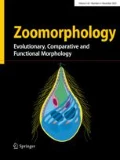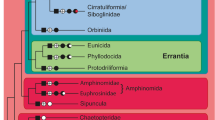Abstract
The segmental ocelli (eyes) in specimens of a European and a Chinese “Polyophthalmus pictus” population have been investigated by transmission electron microscopy. The ocelli are situated in corresponding positions in the same segments and reveal similarities in their general structure. They consist of one photoreceptor cell with microvilli-bearing processes and a pigment cup, the receptor processes project into an extracellular cavity formed by the sensory cell and a few supporting cells, the pigment cup is formed by mesodermal cells, and basiepidermal glial cells and gland cells lie above the sensory cell. However, the ocelli differ in size and number of cells, number and dimensions of cellular elements as well as presence or absence of certain cell types associated with the ocelli. There is only little variation in these characters and there is no overlap, so that they distinctly separate the specimens of the two populations. These differences are in the same range, or even larger, as those observed between the ocelli of other closely related polychaete species. Therefore, the specimens from Qingdao, China, are described as a new species of the Opheliidae, Polyophthalmus qingdaoensis sp.n., although specimens from Qingdao, China, and the Island of Giglio, Italy, are almost inseparable by light microscopy except for a few subtle differences.
Similar content being viewed by others
References
Day JH (1967) A monograph on the Polychaeta of Southern Africa. Brit Mus Nat Hist Publ 656:1–842
Dragesco-Kerneis A (1980) Taches oculaires segmentaires chez Dasychone (Annélides polychètes). Étude ultrastructurale. Cah Biol Mar 21:287–302
Eakin RM, Brandenburger JL (1985) Effects of light and dark on photoreceptors in the polychaete annelid Nereis limnicola. Cell Tissue Res 242:613–622
Eakin RM, Hermans CO (1988) Eyes. In: Westheide W, Hermans CO (eds) The ultrastructure of Polychaeta. Mikrofauna Mar 4:135–156
Eckelbarger KJ, Grassle JP (1983) Ultrastructural differences in the eggs and ovarian follicle cells of Capitella (Polychaeta) sibling species. Biol Bull 165:379–393
Eclelbarger KJ, Grassle JP (1987a) Interspecific variation in genital spine, sperm and larval morphology in six sibling species of Capitella. Bull Biol Soc Wash 7:62–76
Eckelbarger KJ, Grassle JP (1987b) Spermatogenesis and sperm storage and comparative sperm morphology in nine species of Capitella, Capitomastus and Capitellides (Polychaeta: Capitellidae). Mar Biol 95:415–429
Ermak TH, Eakin RM (1976) Fine structure of the cerebral and pygidial ocelli in Chone ecaudata (Polychaeta: Sabellidae). J Ultrastruct Res 54:243–260
Fauchald K (1977) The polychaete worms. Definitions and keys to the orders, families and genera. Nat Hist Mus Los Angeles C Sci Ser 28:1–188
Fauchald K (1984) Polychaete distribution patterns, or: can animals with palaeozoic cousins show large-scale geographical patterns? In: Hutchings PA (ed) Proceddings of the first international polychaete conference, Sydney 1983. The Linnean Society of New South Wales, pp 1–6
Fauvel P (1925a) Bionomie et distribution géographique des annélides polychètes. Bull Soc Océanogr Fr 6:307–312
Fauvel P (1925b) Sur les ophéliens des côtes de France. Bull Soc Zool Fr 50:77–88
Gelder SR (1974) A review of the zoography and habitat data of the genus Nerilla Schmidt, 1848 (Annelida: Archiannelida). J Nat Hist 8:631–643
Grassle JP, Grassle JF (1976) Sibling species in the marine pollution indicator Capitella (Polychaeta). Science 192:567–569
Hartman O (1959) Catalogue of the polychaetous annelids of the world. Part II. Allan Hancock Foundation Pub Occas Paper 23:355–628
Hartman O (1960) Systematic account of some marine invertebrate animals from the deep basins of southern California. In: Hartman O, Barnard JL (eds) The benthic fauna of the deep basins of southern California. Part 2. Allan Hancock Pac Exp 22:69–215
Hartman O (1965) Catalogue of the polychaetous annelids of the world. Supplement 1960–1965. Allan Hancock Foundation Pub Occas Paper 23:1–197
Hartmann-Schröder G (1971) Annelida, Borstenwürmer, Polychaeta. In: Dahl F (ed), Die Tierwelt Deutschlands und der angrenzenden Meeresteile, vol 58. Gustav Fischer, Jena, pp 1–594
Hermans CO (1969) Fine structure of the segmental ocelli of Armandia brevis (Polychaeta: Ophelliidae). Z Zellforsch 96:361–371
Kerneis A (1975) Etude comparée d'organes photorécepteurs de Sabellidae (Annélides polychètes). J Ultrastruct Res 53:164–179
Kükenthal W (1887) Die Opheliaceen der Expedition der “Vettore Pisani”. Jena Z Naturwiss 20:511–580
Meyer E (1882) Zur Anatomie und Histologie von Polyophthalmus pictus Clap. Arch Mikrosk Bonn 21:769–823
Nordheim H von (1989) Vergleichende Ultrastrukturuntersuchungen der Eu- und Paraspermien von 13 Protodrilus-Arten (Polychaeta, Annelida) und ihre taxonomische und phylogenetische Bedeutung. Helgoländer Meeresunters 43:113–156
Pfannenstiel H-D, Grünig C (1990) Spermatogenesis and sperm ultrastructure in the polychaete genus Ophryotrocha (Dorvilleidae). Helgol Meeresunters 44:159–171
Pietsch A, Westheide W (1985) Ultrastructural investigations of presumed photoreceptors as a means of discrimination and identification of closely related species of the genus Microphthalmus (Polychaeta, Hesionidae). Zoomorphology 105:265–276
Purschke G (1990a) Fine structure of the so-called statocysts in Protodrilus adhaerens (Protodrilidae, Polychaeta). Zool Anz 224:286–296
Purschke G (1990b) Ultrastructure of the “statocysts” in Protodrilus species (Polychaeta): Reconstruction of the cellular organisation with morphometric data from receptor cells. Zoomorphology 110:91–104
Purschke G (1992) Ultrastructural investigations of presumed photoreceptive organs in two Saccocirrus species (Polychaeta, Saccocirridae). J Morphol 211:7–21
Verger-Bocquet M (1981) Étude comparative, au niveau infrastructural, entre l'oeil de souche et les taches oculaires du stolon chez Syllis spongicola Grübe (Annélide polychète). Arch Zool Exp Gén 122:253–258
Verger-Bocquet M (1991) Sensory structures. In: Harrison FW, Gardiner SL (eds) Microscopic anatomy of invertebrates, vol 7, Annelida. Wiley-Liss, New York, pp 181–196
Westheide W (1977) The geographical distribution of interstitial polychaetes. In: Sterrer W, Ax P (eds) The meiofauna species in time and space. Mikrofauna Mar 61:287–302
Westheie W, Purschke G (1988) Organism processing. In: Higgins RP, Thiel H (eds) Introduction to the study of meiofauna. Smithsonian Institution Press, Washington, pp 146–160
Westheide W, Rieger RM (1987) Systematics of the amphiatlantic Microphthalmus-listensis-species-group (Polychaeta; Hesionidae): Facts and concepts for reconstruction of phylogeny and speciation. Z Zool Syst Evolutionsforsch 25:12–39
Westheide W, Purschke G, Middendorf K (1991) Spermatozoal ultrastructure of the taxon Enchytraeus (Annelida, Oligochaeta) and its significance for species discrimination and identification. Z Zool Syst Evolutionsforsch 29:323–342
Author information
Authors and Affiliations
Rights and permissions
About this article
Cite this article
Purschke, G., Ding, Z. & Müller, M. Ultrastructural differences as a taxonomic marker: the segmental ocelli of Polyophthalmus pictus and Polyophthalmus qingdaoensis sp.n. (Polychaeta, Opheliidae). Zoomorphology 115, 229–241 (1995). https://doi.org/10.1007/BF00393803
Accepted:
Issue Date:
DOI: https://doi.org/10.1007/BF00393803




